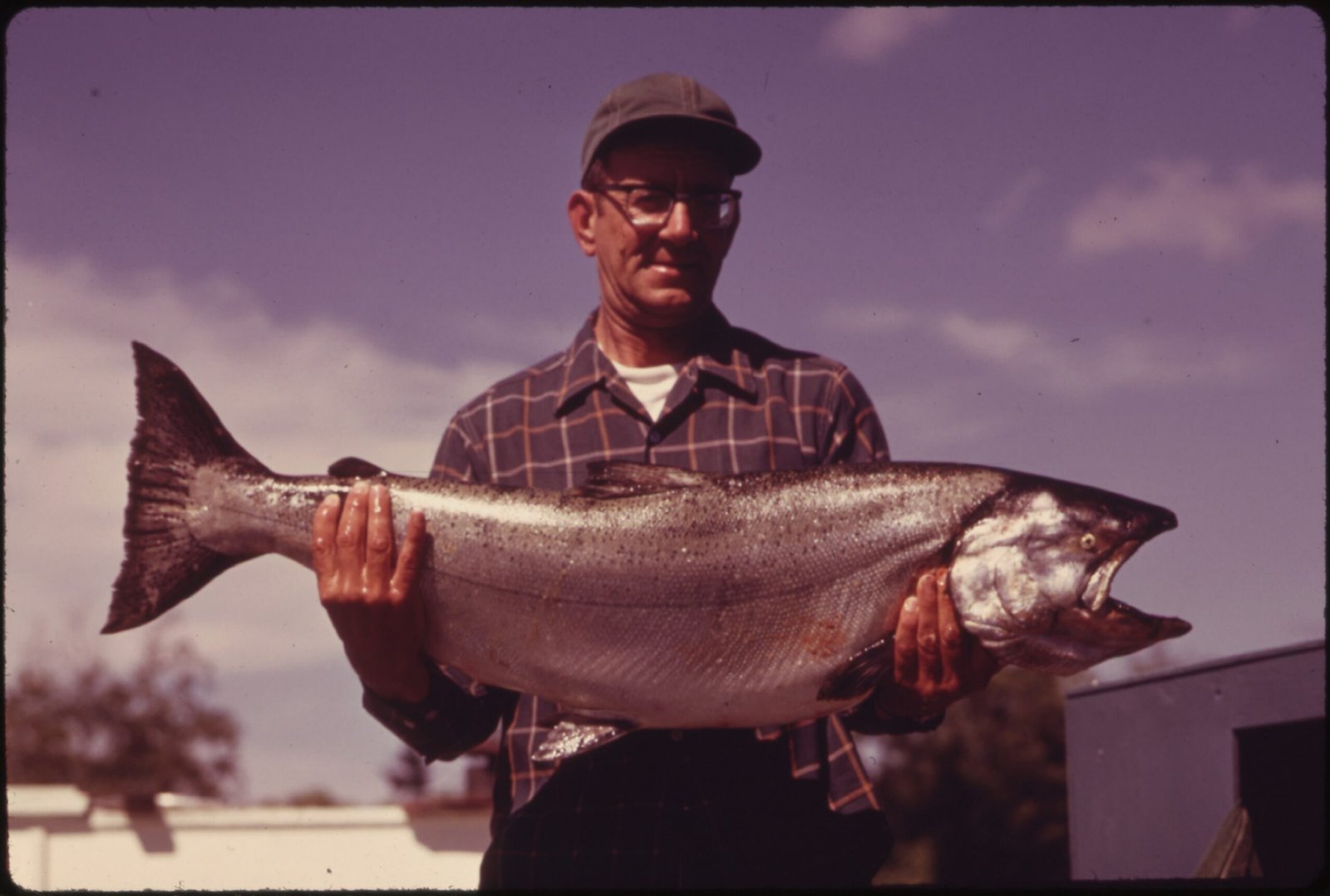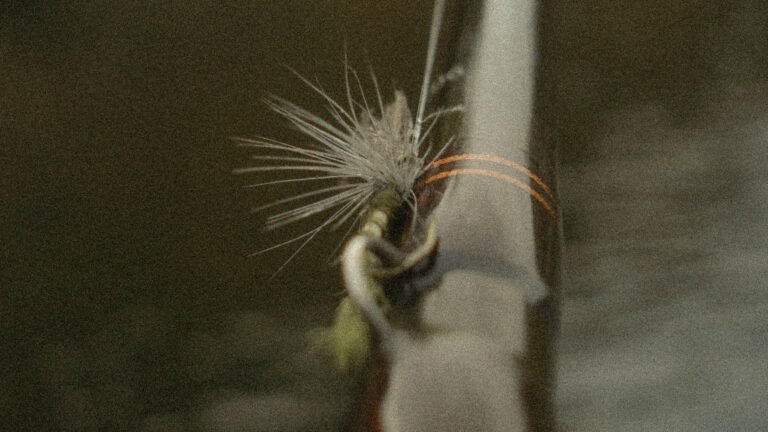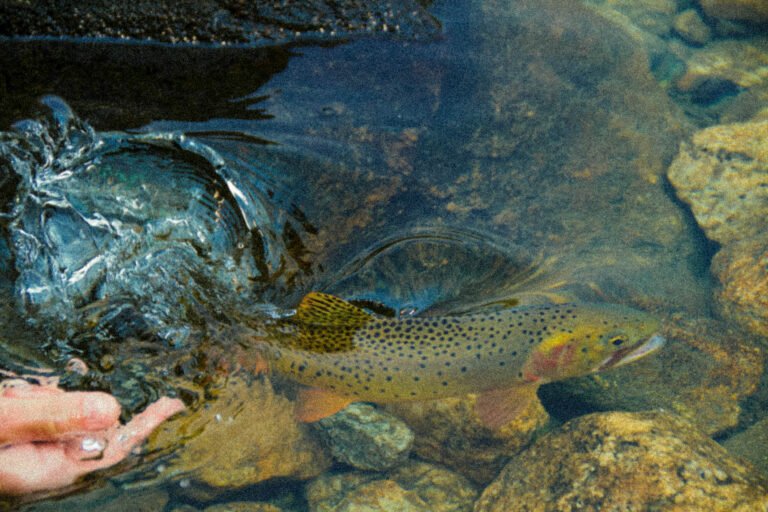“A river is water in its loveliest form; rivers have life and sound and movement and infinity of variation, rivers are veins of the earth through which the lifeblood returns to the heart.” – Roderick Haig-Brown
INTRODUCTION & CONTEXT
B.C. fishermen enjoy an abundance of fishing opportunities for Pacific salmon. Starting in the late summer and early fall, Pink, Sockeye, Coho, Chinook (Spring/King), and Chum (Dog) Salmon can be found in rivers around the province.
There are countless methods with which anglers can catch salmon. For the purposes of this guide, we’ll focus on river fishing using two of the most common methods, namely drift fishing and fishing with lures. We’ll leave fly fishing for another guide.
Making no apologies, this guide is long. If it could be as informative and practical at a shorter length, it would be so. Salmon fishing in freshwater is a nuanced and even challenging sport at times. It is, however, immensely rewarding when success is found.
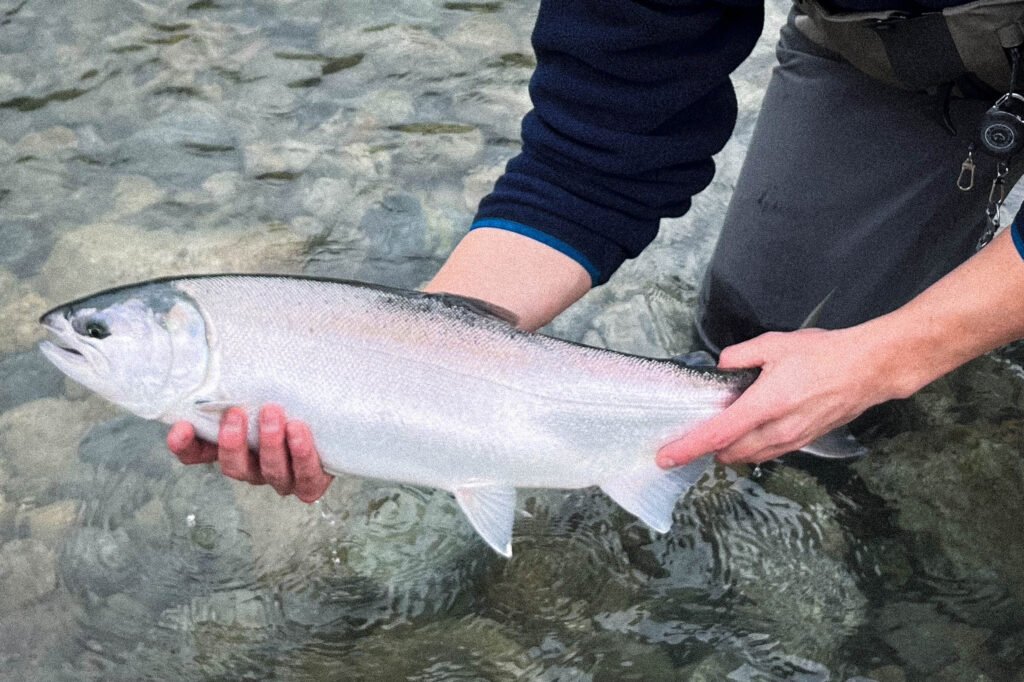
This guide will provide you with the foundational knowledge you need to get started. Keep in mind it can take years to hone your skills and gain confidence on the river. Do not be discouraged if you don’t see immediate results. As always, the experience of fishing is the ultimate reward.
*Note: This is not another AI article. These are the proven methods and gear used by B.C. anglers to catch salmon in freshwater.
TABLE OF CONTENTS
DO SALMON BITE IN FRESH WATER?
To conserve energy, Pacific salmon stop actively feeding once they enter rivers to spawn, instead drawing on their stored fat to fuel their migration.
In short, they don’t eat out of hunger—rather, their strikes are triggered by aggression and territorial behaviour. This partially explains why a school of fish will sometimes completely ignore lures, flies, and baits.
The question of why salmon bite has long been the subject of research and debate. Here are the main suspected reasons why they do:
- Egg eating: Ok, so salmon do not typically feed once they enter rivers, but research has shown that Coho and Chinook will eat eggs out of competitive aggression. In some studies, up to 40% of salmon surveyed were found with eggs in their stomach. You can see this for yourself next time you harvest a salmon. Obviously, this explains why cured roe and beads can be so effective.
- Aggression and territoriality: As salmon approach their spawning grounds, they become more aggressive and territorial. They often strike when bright lures invade their space.
- Residual feeding behaviour: Even after they enter freshwater and stop feeding, salmon can still exhibit leftover ocean feeding instincts. Lures that mimic the size, colour, or movement of traditional prey may trigger these automatic reactions, especially with a convincing presentation.
WHAT GEAR YOU NEED
Ultimately, you’ll want two rods. One for casting lures and one for drift fishing. You don’t need fancy gear or a lot of tackle, so feel free to choose whatever fits your budget. Given the choice, I’d prioritize higher-quality reels over expensive rods.
THE IDEAL ROD COMBO:
| Rod | Length | Power | Line Rating | Action |
| Spin Rod | 8’6″ | Medium | ~8-17 LB | Moderate Fast |
| Drift Rod | 10’6″ + | Medium Heavy | ~12-25 LB | Moderate Fast |
Power = How much force it takes to bend the rod (“stiffness” or “backbone”)
Line rating = Range of line strengths the rod is designed for
Action = Where the rod bends when pressure is applied (tip sensitivity)
SPIN FISHING SETUP:
- The spin rod: My personal preference for an all-around casting machine is an 8’6″ medium power rod with a moderate-fast action. If you’re like me and mainly fish for Coho and Pink Salmon with spin tackle, the medium power will be adequately strong, and the quick action will provide enough sensitivity to feel and set on light bites. Makers like Daiwa, Shimano, Fenwick, Okuma, and Ugly Stik produce suitable rods.
- The spin reel: Cheap reels tend to have jerky drag systems that don’t hold steady tension when fighting fish. This can lead to inconsistent line pressure and more lost fish. The most important thing to look for is a reel with several (≥5) bearings. If possible, test the drag before making a purchase. When selecting a reel, you’ll want something that can hold enough line to let big fish run. Typically, manufacturers label reel sizes in the thousands, so aim for sizes around 3000 to 4000.
- The line: I line my spinning reel with 30 LB braid. It’s durable, lasts a long time, and never breaks. For leaders, get fluorocarbon line between 12-17 LB, depending on the species you are targeting. Some will debate if the extra cost of fluorocarbon line is justified, but I think it is. It’s more abrasion-resistant, sinks better, and is nearly invisible underwater. Use a simple swivel to attach the sections of line.
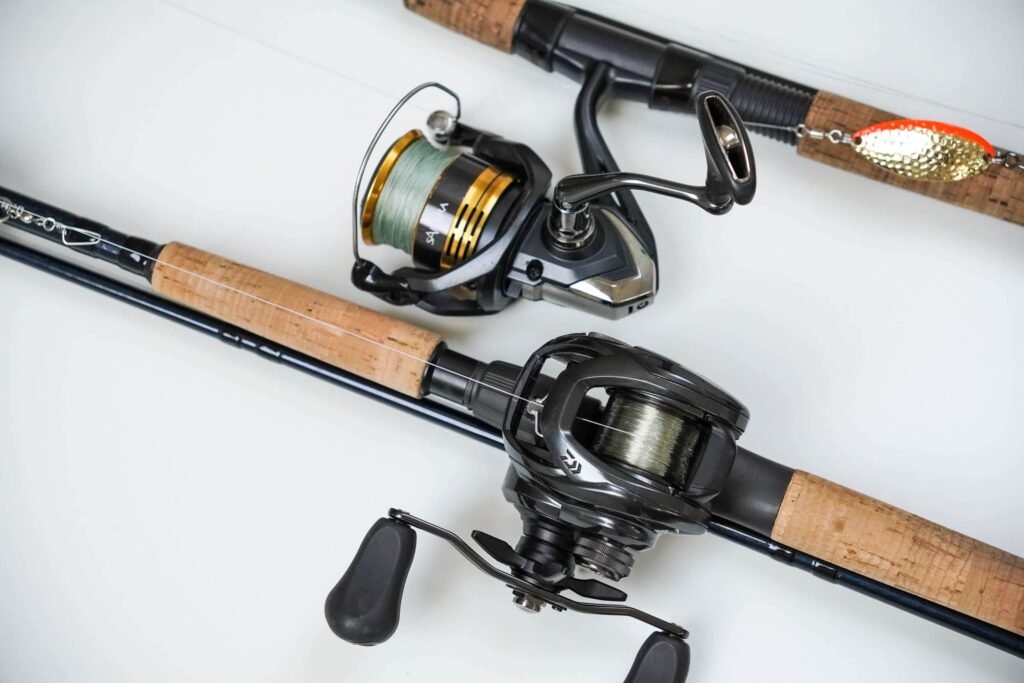
DRIFT FISHING SETUP:
- The drift rod: I prefer a 10’6″ medium-heavy rod with a moderate-fast action. The extra power will come in handy when fighting big fish, and the long length will help you keep your line off the water and achieve drag-free drifts. More on this later. I use a baitcasting configuration (with guides and the reel on top) to help get quicker hook sets and let line out more smoothly.
- The drift reel: Again, a high-quality reel will do you favours. I use a 300-size baitcasting (level wind) reel.
- The line: I prefer 17-20 pound monofilament line as the extra thickness (over braid) helps hold a float firmly in place; however, braid works perfectly fine. Again, fluorocarbon is best for leaders.
Don’t get me wrong, all of this can add up. The simplest way to get started is to start with a simple spin casting setup and a small selection of lures. This will get you started without breaking the bank, and will give you a chance to test the sport before becoming a full-blown devotee.
SALMON FISHING WITH LURES
The simplest way to fish for salmon, apart from trolling in a boat, is by casting and retrieving lures. Coho and Pink Salmon are the most receptive to lures, but Chum and Chinooks can be caught with this method, too. Sockeye typically do not bite at all in freshwater—instead, fishermen tend to “floss” for Sockeyes. Here are a few lures worth trying, with no sponsorship or affiliation.
BEST SALMON SPINNERS:
- Prime Lures “Clean up Crew”: This lure’s heavy, torpedo-shaped body helps it sink quickly, making it ideal for fishing deep. While many colour options exist, chartreuse, pink, green, and orange/red are reliable basics. Size #4 is best in most cases.
- Blue Fox “Vibrax” Spinner: Best for shallower water. This spinner has a lighter, wider body that swims higher in the water. It also makes a vibrating sound underwater, which can trigger fish to strike. Get some in sizes #4.
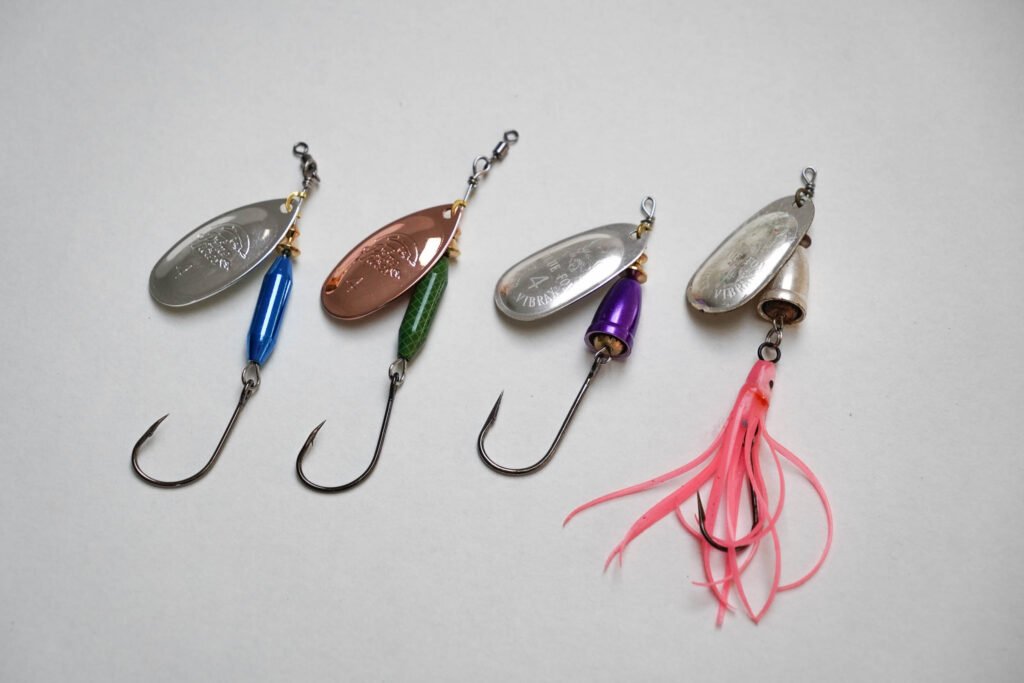
Some people, including myself, modify spinners by adding a hoochie, or plastic squid, above the hook to entice fish (shown above). This can be beneficial when you want a big and loud presentation that stands out in worse visibility conditions.
BEST SPOONS AND JIGS FOR SALMON:
- Prime Lures “Glory” Spoon: This is a wider spoon that is known to catch salmon in both fresh and saltwater environments. It comes in a variety of colours, so get a small variety in silver, brass, and copper with different paint. 18 or 12 gram works, though heavier sinks better and casts farther.
- Gibbs Croc: The Gibbs Croc is one of the most well-known and popular lures. Larger sizes in these can work great for salmon. Gibbs also makes the “Koho” spoon that has a heavier and wider body. Both can be highly effective.
- Twitching Jigs: Brands aside, 1/2 and 3/4-ounce lead-head marabou jigs can be deadly in rivers. Colour depends on your species, but variations of pink, purple, light blue, chartreuse, and black can be great for Coho, and, of course, more pink variations are preferred by Pinks.
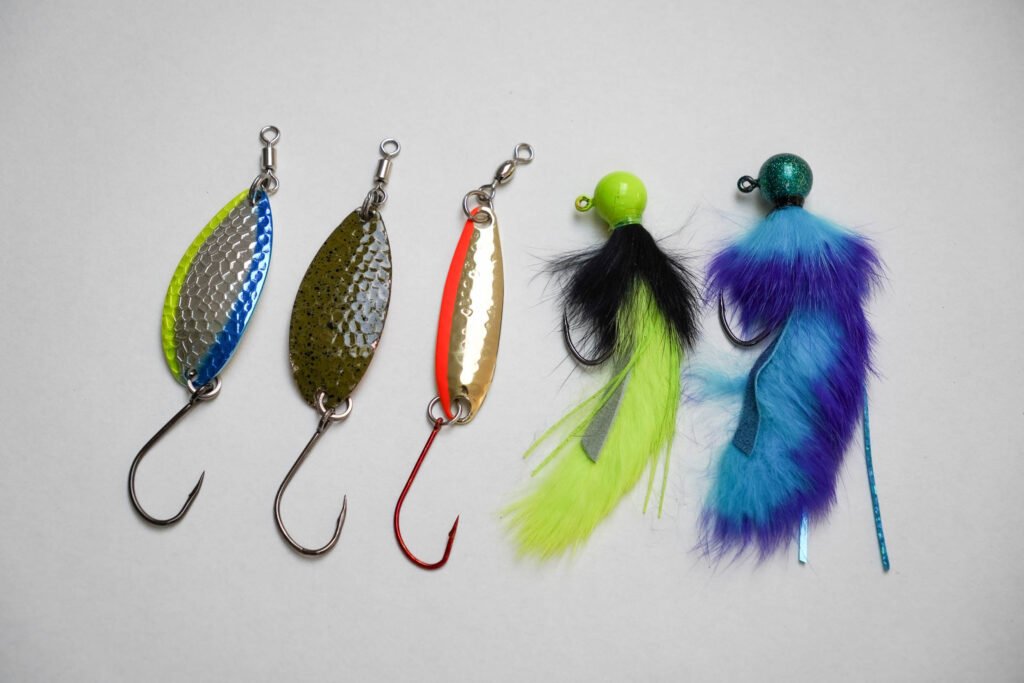
For saltwater salmon fishing, buzz bombs and p-line laser minnows are popular, as well as the famed “Tasmanian devil” lure for pinks.
There is a nearly unlimited number of lures you could catch salmon with. I’ve outlined a few ones to try, but by no means is this an exhaustive list.
The folks at your local tackle shop will be happy to provide more recommendations and local knowledge.
HOW TO CHOOSE LURE COLOUR
The best colour lure to use is not an exact science and depends on the species you are targeting and the water conditions.
At high water: When river levels are flowing high and the water is more stained, salmon will strike fairly readily at a good presentation without much concern for your lure colour. If water clarity is poor, bright and loud colours (chartreuse, red/orange) and dark colours like black will help your lure get noticed.
At low water: Fish will likely be more picky in lower and clearer water, and therefore natural colours like green, copper and gold will work best.
Below is a rough guide to help you make informed lure choices. All colours mentioned below can and should be used in combination with each other.
| Species | Top Colour #1 | Top Colour #2 | Top Colour #3 | Top Colour #4 |
| Coho | Chartreuse | Pink | Red/Orange | Blue/Purple |
| Pink | Pink | Chartreuse | N/A | N/A |
| Chinook | Chartreuse | Red/Orange | Purple | Blue |
| Chum | Purple | Pink | Chartreuse | Black |
SPIN CASTING TECHNIQUE
Water depth and current speed dictate which lure will work best. In deeper water, heavy-weighted jigs can help you get down to fish lying below. In faster and shallower water, spoons and spinners will swing nicely across the current.
Cast your lure about 15–20 degrees downstream, let it sink briefly, then reel slowly as it swings across the current.
Reel just fast enough to keep your spoon fluttering or your spinner blades turning. If the current in the middle of the river is strong, you may not even need to reel; here, the current will do all of the work.
Setting your reel drag: Keep your drag set tight enough to get a solid hook set, but loose enough so the fish can run. You’ll want to let the fish run initially before beginning the fight.
SPIN CASTING LEADER SETUP
You’ll want to adjust your leader strength for the species of salmon you are targeting. On top of your 30 LB mainline, you can use:
- 6-8 LB rated leader for Pink Salmon
- 10-12 LB rated leader for Coho Salmon
- 12-20 LB rated leader for Chum Salmon
Keep in mind you won’t be directly hanging a fish off of your line—your reel and rod will absorb a lot of the force that a fish exerts.
DRIFT FISHING FOR SALMON
Drift fishing is effective for catching most species of Pacific Salmon, but most of the time, drift fishermen are targeting Coho and Chinook Salmon. The basic concept here is to mimic natural salmon eggs floating downstream with plastic beads or roe to trigger fish to bite.
By casting upstream with a balanced float, the current carries your rig and presents your bait (or bead/lure) to holding fish. A correctly set float will glide along the surface, precipitously dropping upon a strike.
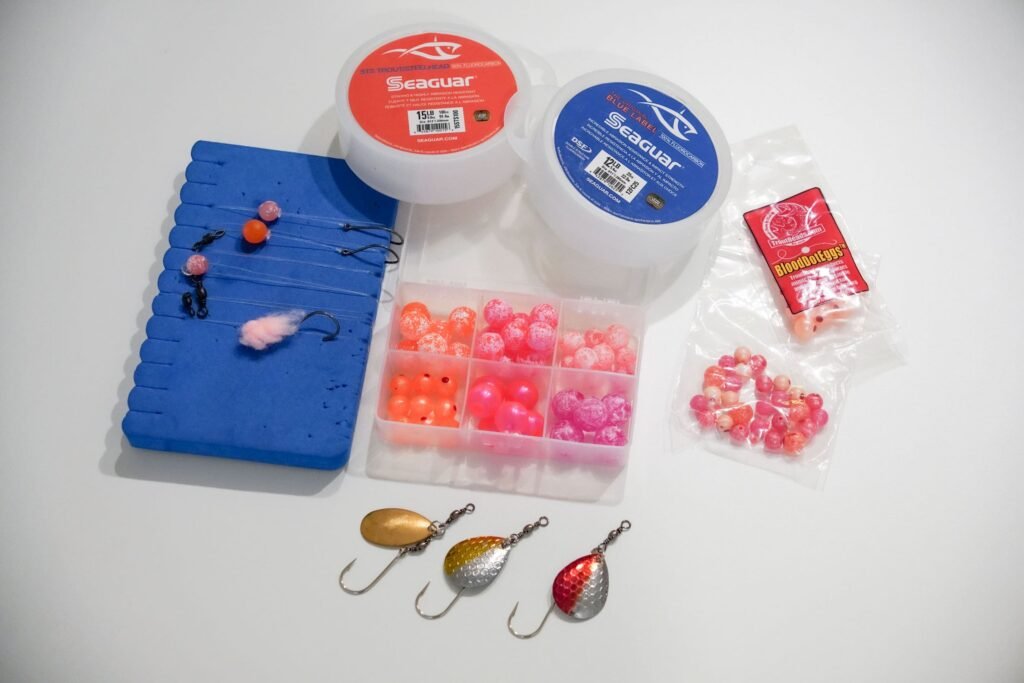
DRIFT FISHING TECHNIQUE
Setting depth: Choosing the correct depth is critically important when drift fishing. Ultimately, you want your presentation to be about one foot off the riverbed. Set it too high, and the fish are less likely to see it. Too low, and you’re likely to snag the bottom.
Estimating the water depth can be challenging, so try comparing it to your height as you wade. Sometimes, you’ll realize that the river is a few feet deeper than it looks when you get in.
A properly set float will drift smoothly across the water. If your presentation is too deep, you’ll see the float start to tilt downstream or bounce up and down as it taps bottom.
If you keep tapping bottom, try reducing your float depth in increments of six inches. Constantly experiment with depth to dial in your technique; eventually, the process will come naturally.
Drag-free drift: To maintain a natural-looking presentation underwater, you must prevent your line from accumulating on the surface of the water. This will create drag on the float, causing your bait to move unnaturally underwater.
To avoid this, carefully mend the line by pointing your rod tip straight up (90° to the ground) and gently lifting the close section of your line off the river’s surface and upstream, thereby straightening the line.
Do your best not to disturb the float. This will cause your presentation to shake unnaturally underwater. This is where rod length comes into play; it allows you to get the rod tip high, giving you the leverage to gently clear the surface film.
HOW TO SETUP A FLOAT
There are as many ways to rig a float as there are to skin a cat. Most commonly, anglers use slide-on plastic float stops above and below their floats so they can quickly adjust their depth. Here is a simple way to attach your float to your line:
1-2 Float Stops → Plastic Bead → 25/20 Gram Float → Plastic Bead → Float stop
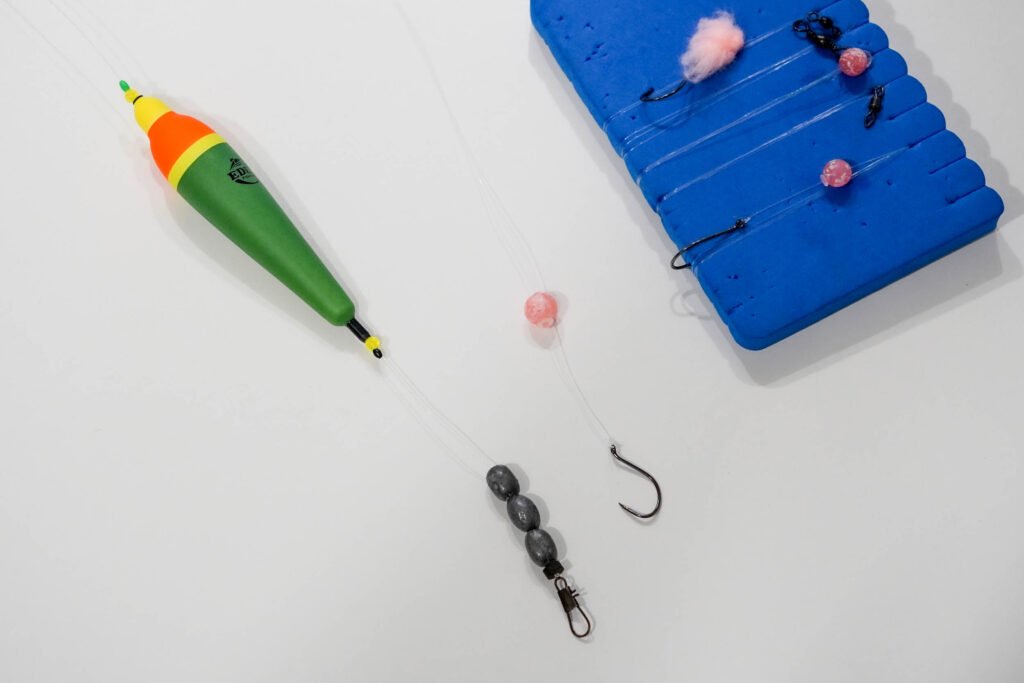
Add weights under your float. Anglers often use egg sinkers or pencil lead weight to counterbalance their floats. Use this as a guide to add the right amount of lead:
| Float | Egg Weights | Pencil Lead (1/4″ diameter) |
| 20 Gram | 3x #9 or 1x #10 and 1x #8 | 2 inches |
| 25 Gram | 1x #7 or 3/4 oz inline sinker | 2.5 inches |
Pro tip: If you are using egg sinkers or pencil lead, add a bead above your knot where the weight rests to prevent the sliding weight from destroying it. If you want to be able to quickly change leaders, add a clip below your weights like this:
Clip (without swivel) → Bead/Rubber → Weights → Sliding Float
I’ve seen guides use toothpicks to stop their floats, so don’t feel like you have to do in any one way. If you’re looking for a visual guide, this beautiful diagram from Pacific Angler spells it out!
LEADER SETUP FOR DRIFT FISHING
As with most things in fishing, your leader length should depend on the depth and speed of the river. In general, keep your leader between 1 to 2.5 feet (12 – 30 inches).
In fast and agitated currents, use a shorter leader (~14″) to ensure your presentation gets down to your desired depth quickly.
In slower water, a longer leader (around 25″) offers more stealth as fish have more time to inspect your rig, and the lighter current allows more time for your presentation to sink deeper.
| Leader Setup | Fast Water | Slower Water | Hook Size |
| Chinook Salmon | 12-16″ | 15-20 LB | 18-26″ | 15-20 LB | 1/0 – 2/0 |
| Coho Salmon | 12-16″ | 12 LB | 18-26″ | 12 LB | 1 – 1/0 |
Again, fluorocarbon is best for float fishing leaders because it is abrasion-resistant and nearly invisible underwater.
Many anglers set up one or two leader boards to neatly store pre-tied leaders for quick and easy changes on the water. A foam leader board with rounded edges is important and will help prevent your leaders from kinking.
Keep in mind these are just rough guidelines for how to think about rigging leaders. There is no substitute for personal experimentation.
CURED ROE
Broadly speaking, fishing with cured roe is the best way to catch Chinook Salmon in rivers. Its natural appearance and unmistakable scent make this bait irresistible to fish.
You can cure your own roe, or buy it at tackle stores. Roe does, however, come with disadvantages. First, it stinks and needs to be replaced often when casting. It’s also expensive and needs to be refrigerated.
Additionally, bait fishing is highly regulated and isn’t permitted in many seasons and river systems. Nonetheless, if you can get past this, it is highly effective.
HARD AND SOFT BEADS FOR SALMON
Soft beads: These are the most commonly used drift presentation if cured roe isn’t permitted. Soft beads come in a variety of colours and shapes to mimic natural eggs or get attention and provoke aggressive strikes (ie: larger and brighter beads).
Soft beads have quickly become a favourite among anglers because of their supposed ability to mimic not only the appearance, but the natural feel of eggs, which apparently causes salmon to less readily spit out the imitations when bitten compared to hard plastic, leading to more solid hook sets.
Some anglers also tie a piece of wool soaked in scent above their bead to help attract fish. Keep in mind that scent counts as bait, so use it only when allowed.
Hard beads: These are preferred by some anglers due to their natural appearance, small size options, and durability. These can work better in fast-moving water, where the additional density helps the bead sink more quickly.
COLORADO BLADES
Colorado spinners/blades are a type of spinner drifted under a float. This isn’t the most popular method, but it can be highly effective when other methods aren’t producing, so it’s worth having a couple of these.
Rig these up with a roughly 16″ leader (adjust for water conditions) and set your float so the spinner is set about 1.5-2 feet off the riverbed.
In fast water, fish them the same as you would a bead. In slower water, you can apply a bit of resistance with your line to gently swing the float and help the blades flutter underwater.
The benefit of drifting blades is that you can more accurately control your depth than when casting normal spinning lures.
WHERE TO FISH FOR SALMON IN RIVERS
Salmon travel a great distance upriver to spawn. As such, they naturally congregate in areas that provide shelter and safety to rest. We call this “holding water.” The best holding water depends on the kind of fish you are targeting and the river’s water level.
Rivers generally follow the pattern of Riffle > Run > Tailout. Understanding this structure is key to knowing where to cast. A riffle is where a river slopes down, creating a fast and shallow section.
Over time, the fast flow erodes the river bottom where it levels out, creating a deeper pool. This is where a run starts (AKA the head).
Deep pools like this make for excellent salmon holding water. Typically, Chinook Salmon congregate near the head of runs, in the slightly faster and more oxygenated water. They rarely ever hold in very slow or stagnant water.
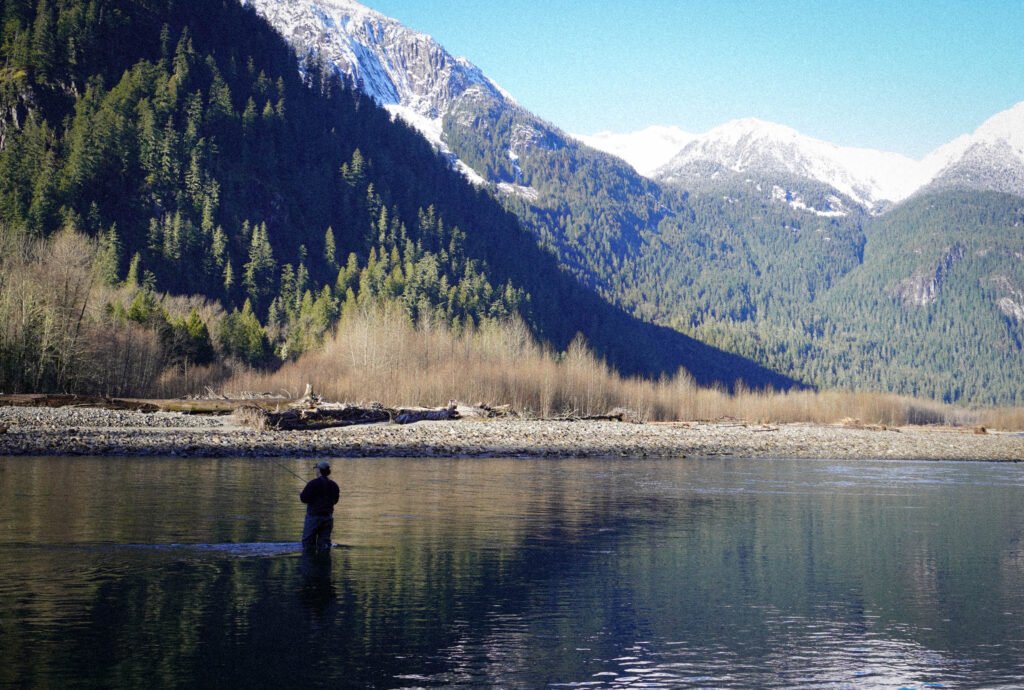
Coho Salmon tend to hang out in side pockets, backeddies, or in areas with overhanging and underwater structure (like logs and rocks).
You can also target seams or bubble lines where two different-speed currents meet. Fish will use these areas to navigate upstream while conserving energy.
During periods of high water, you’ll want to find pockets of slower water. Fish will stop here for respite from the heavy current. If the water is extremely high, the fish will push to the sides of rivers away from the heavy current.
LICENSING AND READING REGULATIONS
*Understanding regulations and having the correct license ensures you fish legally while respecting salmon populations. In B.C., license sales directly support salmon conservation.
To fish for salmon in British Columbia, anglers must have the proper freshwater (non-tidal) and/or tidal (saltwater) license, plus a salmon conservation stamp if retaining fish. Please note that single-barbless hooks are required in all streams/rivers in B.C.
REQUIRED LICENSES
- Purchase a recreational B.C. freshwater fishing license here.
- Purchase a B.C. tidal fishing license here.
- Read the recreational salmon fishing regulations in British Columbia by fishery management area here.
UNDERSTANDING REGULATIONS
Remember that if a salmon species is not specifically listed for a given body of water, then you cannot fish for or retain that species in that location. Only the salmon species with open seasons and possession limits explicitly shown in the table are allowed to be targeted and retained. Additionally, you may only target salmon in the bodies of water listed on the Fisheries and Oceans Canada website here.
Since many Pacific Salmon look alike when they first enter rivers, knowing how to identify each species is critically important to avoid penalties. Here’s a guide to help tell them apart. Always be sure of a Salmon’s species before harvesting it. If you’re not 100% sure, it’s best to release the fish.
Additionally, be on the lookout for hatchery fish vs. wild fish. In many areas, retention is only open for hatchery fish, which are marked by the removal of their adipose fin (on their back, behind their dorsal fin). More on this here.
THE VALUE OF SALMON
Pacific salmon are one of the West Coast’s most precious resources. Many view salmon as valuable due to their importance to human enterprise. Sure, commercial and recreational fishing create hundreds of millions of dollars in economic value yearly. And yes, anglers can find sport in catching salmon and feed their families with their meat. But their value to the world extends far beyond human uses.
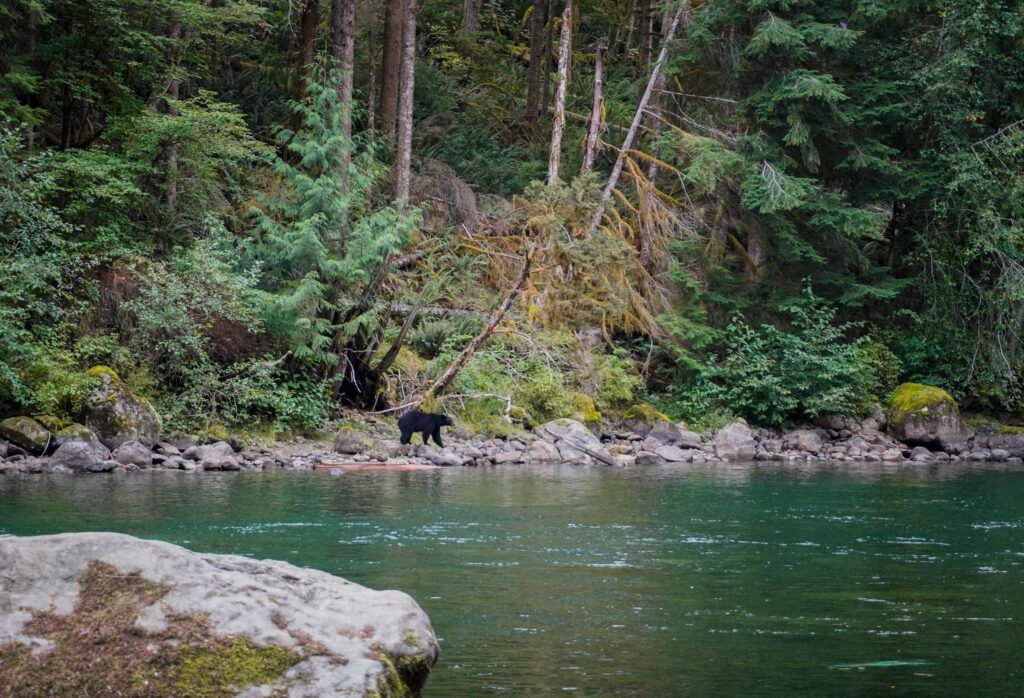
Consider the nutrients salmon bring back to the land. In some coastal B.C. watersheds with strong salmon runs, as much as 75% of the nitrogen in certain tree species comes directly from decayed salmon carcasses. In average coastal forests, the figure is closer to 50%. Salmon not only feed bears, birds, and countless other wildlife, but they also feed the forest itself.
Pacific salmon also hold a profound importance to Indigenous tribes in the Pacific Northwest—not only as food, but also in cultural, spiritual, and economic dimensions.
Salmon are a keystone species in the Pacific Northwest, and support our environment in countless unexpected ways. Maintaining their stocks is of the utmost importance. Their habitat is sensitive and can be harmed by fishing. Please, do your part to maintain our rivers and streams.
ETHICAL FISHING
Freshwater salmon fishing is riddled with bad actors. Snagging, pollution, and poaching, namely, cast a bad light on the sport. Here are a couple of things you can do to help maintain the integrity of the sport:
- Practice safe handling techniques—minimize contact with fish you intend to release, keep them wet and in the water as much as possible, and properly revive fish prior to release. Additionally, avoid dragging or kicking fish onto the riverbank. They will flop around and bonk themselves.
- Respect nesting salmon and do not fish over their nests (redds). These are usually identified by a small rock nest guarded by a pair of Salmon.
- Pack out all of your trash, particularly fishing line, and pick up any you come across.
- Release any foul-hooked or snagged fish with minimal contact.
Ethical anglers always do more than what is required by law and less than what is allowed by it. This can mean different things to different people, but the ethos remains the same.
Thank you for reading, and happy fishing.
